Personal Protective Equipment (PPE) Market Size
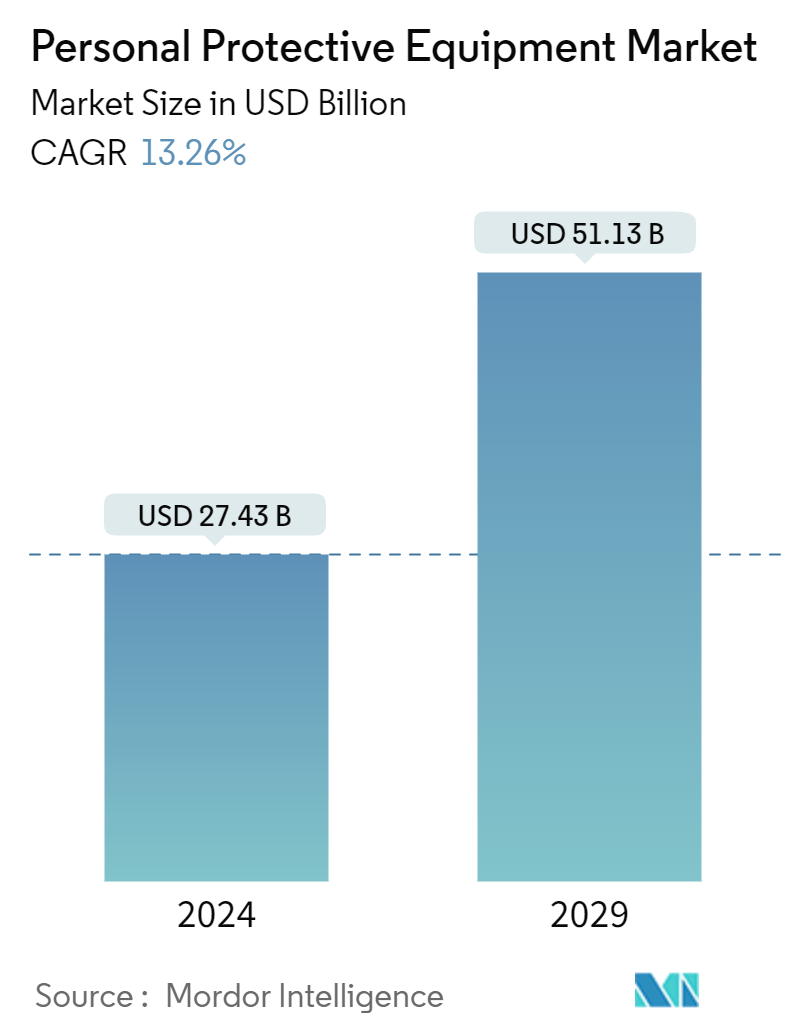
| Study Period | 2019 - 2029 |
| Market Size (2024) | USD 27.43 Billion |
| Market Size (2029) | USD 51.13 Billion |
| CAGR (2024 - 2029) | 13.26 % |
| Fastest Growing Market | Asia Pacific |
| Largest Market | North America |
Major Players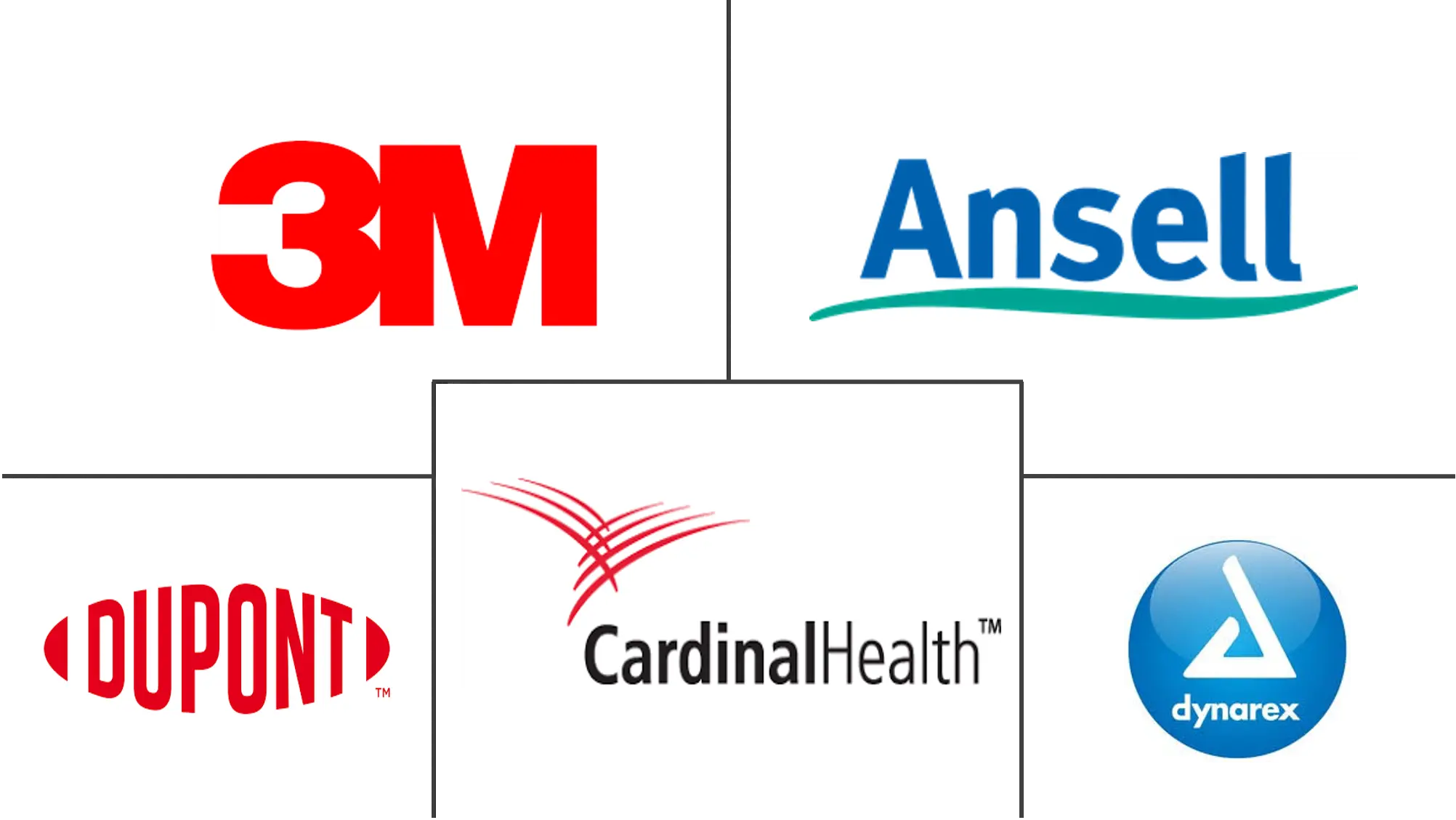
*Disclaimer: Major Players sorted in no particular order |
Personal Protective Equipment (PPE) Market Analysis
The Personal Protective Equipment Market size is estimated at USD 27.43 billion in 2024, and is expected to reach USD 51.13 billion by 2029, growing at a CAGR of 13.26% during the forecast period (2024-2029).
- Rapid growth in the construction sector and awareness of protecting employees in the workplace are the main factors that have led to the widespread use of personal protective equipment.
- Since the COVID-19 pandemic, demand for PPE has risen significantly. The virus's rapid spread necessitated the widespread use of PPE to protect individuals from spreading the infection. PPE such as face masks, gloves, face shields, gowns, and respiratory protection became essential for healthcare workers, essential workers, and the general public to prevent the transmission of the virus.
- Government authorities have issued guidelines and regulations mandating PPE in certain specifications at both federal and state levels. For instance, mask mandates were implemented in many regions to control the spread of COVID-19. These regulations have increased the demand for PPE across different sectors, including retail, hospitality, transportation, and education.
- • With the COVID-19 pandemic affecting approximately 687 million people worldwide (as of August this year), the demand for safe medical and protective products such as gloves, masks, covers, pants, goggles, and face masks has increased. Therefore, the previous estimate for the growth of the personal protective equipment market has increased. The COVID-19 pandemic caused restrictions on the production of other products, and many manufacturers have switched to PPE production, leading to an increase in some regions in the region.
- Occupational Safety and Health Administration (OSHA) wants the PPE assemblies to meet or equal the American National Standards Institute (ANSI) standards. ANSI had set safety standards since the 1920s when it recommended head and eye protection for industrial workers. Falls are a common cause of death on construction sites, so wearing appropriate protective equipment, such as a safety belt or respirator, to protect the lungs from harmful gases, vapors, and particles is essential.
- Infection control requires specific personal protective equipment for use in the healthcare environment and must comply with FDA regulations. Supplier Approved Standard Protective Equipment compliance applies to surgical masks, N95 respirators, medical gloves, and gowns.
- Furthermore, an increase in occupational accidents in several end-user industries, including oil and gas, automotive, refining, and metal manufacturing, is pushing personal protective equipment market trends. Increasing workplace dangers and the Occupational Safety and Health Administration's strong regulatory framework to ensure employee safety is expected to fuel market expansion globally.
Personal Protective Equipment (PPE) Market Trends
Surgical Masks and N95 Respirators to Experience Significant Growth
- Surgical masks serve as personal protective equipment, shielding wearers from airborne particles and liquid contaminants. According to a NIOSH study, about 78% of participants reported using surgical masks for various hazards, with applications noted at 14% for ribavirin and exceeding 90% for surgical smoke. The N95 respirator, a respiratory protective device, is engineered to ensure a tight facial fit while providing highly efficient filtration of airborne particles.
- Surgical masks are commonly employed in scenarios requiring respiratory protection, such as when compounding or administering antineoplastic drugs or near surgical smoke. Although surgical masks effectively block splashes and large droplets, their inability to filter out tiny particles from coughs, sneezes, or specific medical procedures renders them unsuitable for multiple uses.
- N95 Respirators, akin to the European FFP2 and FFP3 standard masks, are optimal for safeguarding the nose and mouth from virus-laden particles. The onset of COVID-19 made face masks a common sight, extending beyond hospitals to all public venues. This surge in mask usage by the general populace resulted in significant supply shortages, particularly for frontline healthcare workers, a situation highlighted in reports from numerous nations.
- Players in the market have expanded their presence through various strategies. For instance, in March 2024, Detmold Medical, initially pivoting to face mask production during the COVID-19 pandemic, unveiled its latest offerings: the Tri-Panel Respirators (as showcased in the image) and an innovative Surgical Mask with Visor. Crafted in the company's cutting-edge laboratory, these masks meet local and international standards, ensuring splash resistance and optimal performance. The newly introduced Surgical Visor features a pleated L3 surgical mask, secure attachment ties, and a fog-treated integrated anti-glare visor.
- Moreover, in March 2024, ResMed unveiled its latest innovation, the AirFit F40, an ultra-compact full-face mask tailored for sleep apnea patients. ResMed crafted the AirFit F40 to deliver the comfort typically associated with smaller masks, all while ensuring top-notch performance. This advancement is poised to enhance therapy compliance for users relying on high-pressure continuous positive airway pressure (CPAP) treatments.
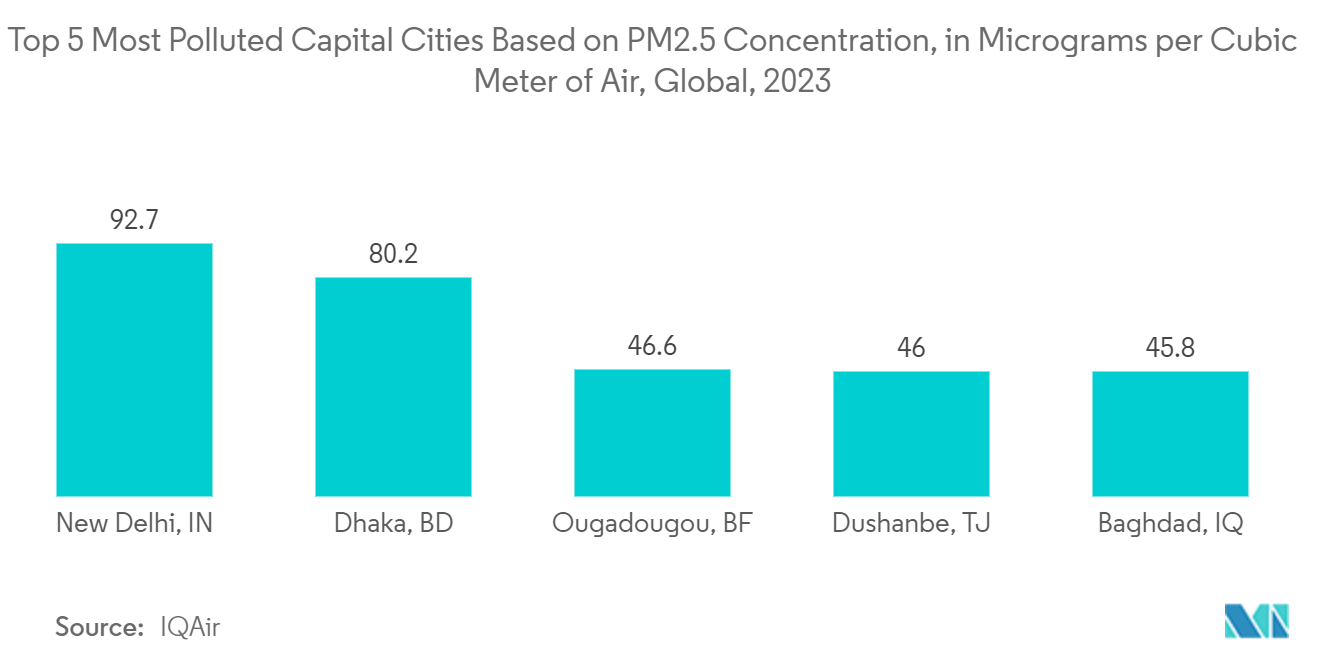
North America is Expected to Hold Significant Market Share
- Companies responding to stringent government regulations on worker safety have increasingly adopted personal protective equipment (PPE) to avert workplace fatalities. Additionally, heightened demand from the healthcare sector and a growing awareness of COVID-19 prevention bolstered sales in the regional PPE market.
- The demand for personal protective equipment (PPE) in the United States has surged, driven by the expansion of sectors, including manufacturing, construction, and mining. This increased demand directly responds to the necessity of safeguarding workers and mitigating risks associated with accidents or exposure to hazardous materials.
- The rising incidence of workplace accidents in the United States has become a significant concern for employers and the government. US regulatory authorities and occupational health organizations have implemented stringent safety regulations and guidelines in response to the heightened focus on worker safety and public health. Consequently, the importance of PPE kits in industrial sectors has been significantly emphasized.
- For instance, OSHA mandates that personal protective equipment (PPE) adhere to specific standards across various sectors, including general industry, maritime, and construction. These standards, often aligned with those set by the American National Standards Institute (ANSI), underscore the importance of safe design and construction for all PPE. Specifically, eye and face protection in the workplace must either meet referenced standards or demonstrate efficacy equivalent to following standards:
- ANSI/ISEA Z87.1-2010 Occupational and Educational Personal Eye and Face Protection Devices
- ANSI Z87.1-2003 Occupational and Educational Personal Eye and Face Protection Devices
- ANSI Z87.1-1989 (R-1998) Practice for Occupational and Educational Eye and Face Protection
- The COVID-19 pandemic significantly hindered the growth of personal protective equipment in different industrial sectors, mainly due to a decline in infrastructure development and installation projects. On the contrary, with the increasing digitization of the world, personal protective equipment (PPE) is also evolving.
- Moreover, the United States has a presence of principal market players engaged in manufacturing PPE. The likes of 3M Co., MSA Safety Inc., Ansell Limited, Honeywell International Inc., EI DuPont de Nemours and Co., Kimberly-Clark Corporation, Lakeland Industries Inc., and Radians Inc. are also promoting the growth of the market in the region.
- The rising incidence of workplace accidents, coupled with the demand for durable mechanical wear resistance and protective gear across industries such as oil and gas, automotive, refining, and metal manufacturing, is set to propel trends in the personal protective equipment market. Heightened workplace hazards, combined with a stringent regulatory framework from the Occupational Safety and Health Administration (OSHA) to ensure employee safety, are expected to boost market growth in North America.
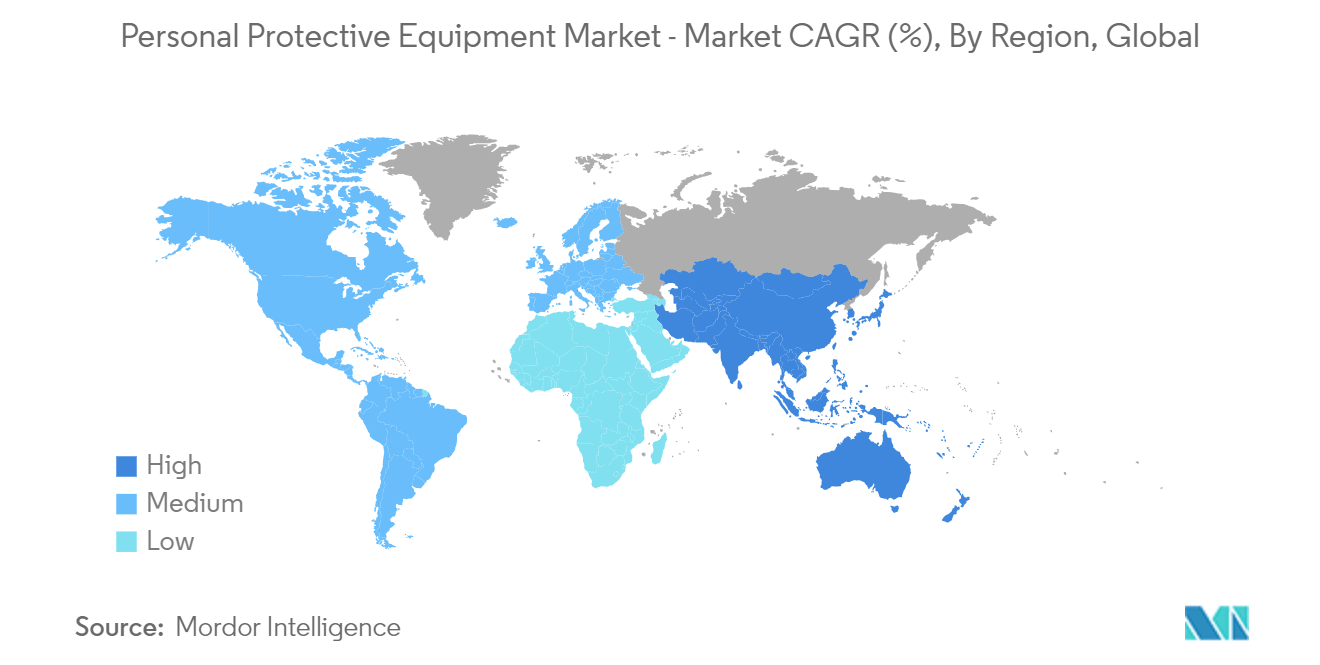
Personal Protective Equipment (PPE) Industry Overview
The personal protective equipment industry is a sector that is focused and dominated by a few major players, such as 3M Company, Honeywell International Inc., Alpha Pro Tech, Ansell Ltd, and Avon Protective Systems. These major players with significant businesses are focused on expanding their customer base abroad. These companies have used strategic partnerships to grow their business and increase profits. However, with the development of technology and new products, small and medium-sized companies are expanding their business by taking on new contracts and exploring new businesses.
May 2024: KARAM Safety, a global provider of PPE and fall protection solutions, acquired Midas Safety India, a manufacturer of hand protection safety products. The company is expanding its presence and enhancing its product offerings through this acquisition.
January 2024: MSA Safety Inc., a global provider of safety solutions for people and facility infrastructures, opened a new Manufacturing Operations Center in Chelalate, Morocco, to produce various personal protective equipment (PPE) product lines. This new facility will enable MSA to meet the rising demand for its safety products in the EMEA region.
Personal Protective Equipment (PPE) Market Leaders
-
3M Company
-
Ansell Limited
-
Cardinal Health Inc.
-
DuPont de Nemours Inc.
-
Dynarex Corporation
*Disclaimer: Major Players sorted in no particular order
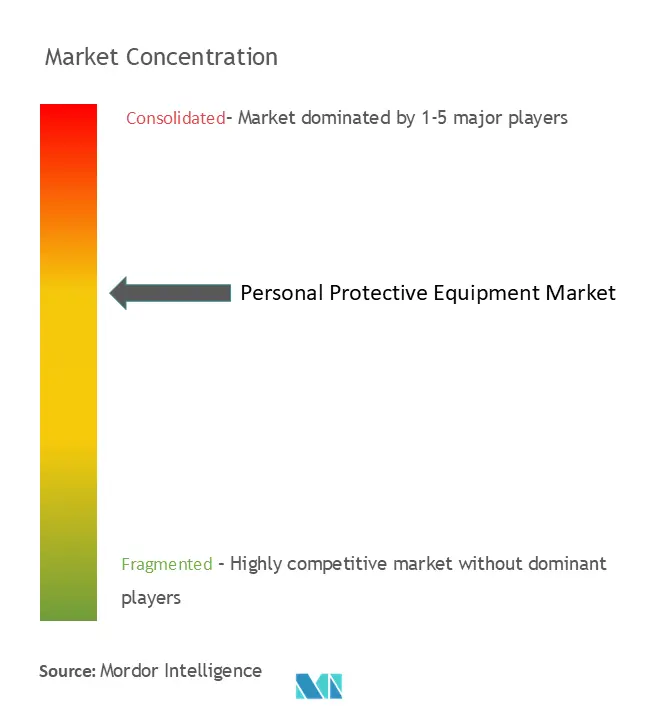
Personal Protective Equipment (PPE) Market News
- April 2024: In light of the rise in PPE counterfeiting amid the COVID-19 pandemic, 3M launched the 3M Verify app. This app aids companies in authenticating their PPE. Utilizing cutting-edge technology, the app scans barcodes on disposable respirator cartons in real time, ensuring the product package's genuineness. When verification succeeds, it offers robust confidence in holding an authentic 3M Disposable Respirator.
- March 2024: The Departments of Homeland Security, Health and Human Services, and Veterans Affairs have released an industry report that estimates federal PPE requirements required under the American-Made Personal Protective Equipment (PPE) Act. The COVID-19 pandemic underscored the federal government's need to lessen its dependence on foreign-sourced PPE. In response, these agencies provided the domestic industry with consolidated federal insights on PPE demands, aiming to enhance understanding of current needs.
Personal Protective Equipment (PPE) Market Report - Table of Contents
1. INTRODUCTION
- 1.1 Study Assumptions and Market Definition
- 1.2 Scope of the Study
2. RESEARCH METHODOLOGY
3. EXECUTIVE SUMMARY
4. MARKET DYNAMICS
- 4.1 Market Overview
-
4.2 Industry Attractiveness - Porter's Five Forces Analysis
- 4.2.1 Bargaining Power of Suppliers
- 4.2.2 Bargaining Power of Buyers
- 4.2.3 Threat of New Entrants
- 4.2.4 Threat of Substitute Products
- 4.2.5 Intensity of Competitive Rivalry
-
4.3 Assessment of the Impact of COVID-19 on the Market
- 4.3.1 Production Dynamics (New Production Capacities, Pure Play PPE Vendors vs Other Production Facilities)
- 4.3.2 Import and Export Regulations Due to COVID-19
- 4.3.3 Top 10 PPE Importing and Exporting Countries
-
4.4 Market Drivers
- 4.4.1 Increasing Incidence of Pandemics and Epidemics
- 4.4.2 Rising Adoption of Cost-effective and Innovative Surgical Procedure
-
4.5 Market Challenges
- 4.5.1 Issues Regarding Disposal and Awareness
- 4.5.2 Supply Shortages
5. MARKET SEGMENTATION
-
5.1 By Product
- 5.1.1 Surgical Masks
- 5.1.2 Respirator Masks (US-based Filter Class (Covers Analysis of Filter Class, such as N-Series, P-Series, and RSeries) and European Filter Class (Covers Analysis of Filter Class, such as FFP1, FFP2, and FFP3))
- 5.1.3 Gloves
- 5.1.4 Suits or Coveralls
- 5.1.5 Aprons
- 5.1.6 Other Products (Protective Eyewear, Goggles, etc.)
-
5.2 By Geography
- 5.2.1 North America
- 5.2.2 Europe
- 5.2.3 Asia-Pacific
- 5.2.4 Rest of the World
6. COMPETITIVE LANDSCAPE
-
6.1 Company Profiles*
- 6.1.1 3M Company
- 6.1.2 Ansell Limited
- 6.1.3 Cardinal Health Inc.
- 6.1.4 DuPont de Nemours Inc.
- 6.1.5 Dynarex Corporation
- 6.1.6 Honeywell International Inc.
- 6.1.7 Kimberly-Clark Corporation
- 6.1.8 Top Glove Corporation Bhd
- 6.1.9 Microgen Hygiene Pvt. Ltd
- 6.1.10 Prestige Ameritech
7. INVESTMENT ANALYSIS AND MARKET OUTLOOK
** Subject To AvailablityPersonal Protective Equipment (PPE) Industry Segmentation
Personal protective equipment or PPE is referred to as equipment that is worn to minimize exposure to hazards causing workplace injuries and illnesses. These injuries or illnesses could arise from contact with varied chemical, electrical, mechanical, and radiological hazards, to name a few. The study characterized the market into products, such as Surgical Masks and N95 Respirators, Gloves, Suits or Coveralls, and Aprons.
The personal protective equipment market is segmented by product (surgical masks, respirator masks, gloves, suits or coveralls, aprons, and other products) and geography (North America, Europe, Asia Pacific, and Rest of World). The market sizes and forecasts regarding value (USD) for all the above segments are provided.
| By Product | Surgical Masks |
| Respirator Masks (US-based Filter Class (Covers Analysis of Filter Class, such as N-Series, P-Series, and RSeries) and European Filter Class (Covers Analysis of Filter Class, such as FFP1, FFP2, and FFP3)) | |
| Gloves | |
| Suits or Coveralls | |
| Aprons | |
| Other Products (Protective Eyewear, Goggles, etc.) | |
| By Geography | North America |
| Europe | |
| Asia-Pacific | |
| Rest of the World |
Personal Protective Equipment (PPE) Market Research FAQs
How big is the Personal Protective Equipment Market?
The Personal Protective Equipment Market size is expected to reach USD 27.43 billion in 2024 and grow at a CAGR of 13.26% to reach USD 51.13 billion by 2029.
What is the current Personal Protective Equipment Market size?
In 2024, the Personal Protective Equipment Market size is expected to reach USD 27.43 billion.
Who are the key players in Personal Protective Equipment Market?
3M Company, Ansell Limited, Cardinal Health Inc., DuPont de Nemours Inc. and Dynarex Corporation are the major companies operating in the Personal Protective Equipment Market.
Which is the fastest growing region in Personal Protective Equipment Market?
Asia Pacific is estimated to grow at the highest CAGR over the forecast period (2024-2029).
Which region has the biggest share in Personal Protective Equipment Market?
In 2024, the North America accounts for the largest market share in Personal Protective Equipment Market.
What years does this Personal Protective Equipment Market cover, and what was the market size in 2023?
In 2023, the Personal Protective Equipment Market size was estimated at USD 23.79 billion. The report covers the Personal Protective Equipment Market historical market size for years: 2019, 2020, 2021, 2022 and 2023. The report also forecasts the Personal Protective Equipment Market size for years: 2024, 2025, 2026, 2027, 2028 and 2029.
Personal Protective Equipment Industry Report
Statistics for the 2024 Personal Protective Equipment market share, size and revenue growth rate, created by Mordor Intelligence™ Industry Reports. Personal Protective Equipment analysis includes a market forecast outlook to 2029 and historical overview. Get a sample of this industry analysis as a free report PDF download.



